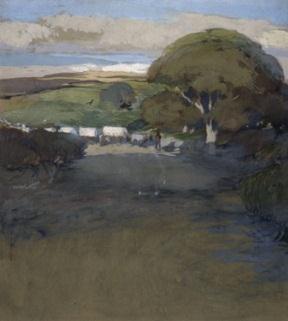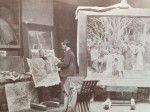
Arthur Mathews
American, 1860-1945
Mexican Period, Study for Panel #7, Sacramento State Capitol Murals, n.d.
watercolor and pencil on paper
27 3/4 x 21 3/4 in.
SBMA, Gift of Harold Wagner
1970.27.5

Photograph of Arthur Mathews in his Studio, n.d.
COMMENTS
Arthur Frank Mathews was one of the most innovative and multitalented American artists of the nineteenth century. He achieved prominence as a tonalist landscape painter, as a furniture maker, as an illustrator, as director of the San Francisco School of Design, and as one of the founders of the American Arts and Crafts Movement.
Tonalism is rooted in the French Barbizon movement, which emphasized atmosphere and shadow. The Tonalist style employs a distinctive technique by the use of color's middle values as opposed to stronger contrast and high chroma, resulting in an understated and compelling overall effect.
The most imposing example of Mathew's mural art can be seen in the state capitol rotunda at Sacramento. The series of twelve panels, completed and installed in 1914, traces the epic development of life in California. Under the titles: Adventure, The Mission Era, The Pioneers, and The City, Mathews depicted scenes of the Indians, the explorers, the missionaries, the settlers, the gold rush, the development of industry and the arts, and finally, his impression of a city of the future.
In order to best serve the decorative function of these murals, Mathews chose to portray the romance and grandeur of his subjects instead of the realism and drama. Technically, he executed these murals in the idiom of his characteristic California Decorative Style, but they are not as well unified with their architectural setting as his other large murals.
- Harvey L. Jones, Mathews: Masterpieces of the California Decorative Style, The Oakland Museum, 1972
